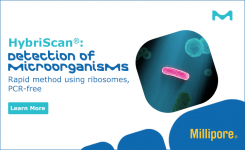Merck is now offering Burkholderia cepacia Selective Agar (BCSA) and Burkholderia cepacia Selective Supplement according to the formulation in the USP-NF chapter 60 introduced in late 2019. The medium to detect the Burkholderia cepacia complex is the latest addition to Merck’s NutriSelect® prime portfolio of culture media. These powdered media feature full compliance with regulatory standards for the pharmaceutical industry and QC based on the Growth Promotion Test according to USP (additionally meeting recommendations of ISO 11133:2014/Amd1:2018/Amd2:2020).
Frequent contaminant of pharmaceuticals
The Burkholderia cepacia complex (Bcc) is a group of very similar bacteria that are present in soil and groundwater but can also infect people and lead to a rapid decline of the lung function and possibly death. These opportunistic pathogens are particularly feared among patients with cystic fibrosis because of their high resistance to antibiotics. Bcc organisms can infiltrate pharmaceutical manufacturing environments and contaminate raw materials and finished drug product. The bacteria have been found numerous times in non-sterile pharmaceutical products. A study has shown that 34% of the product recalls between 2004 and 2011 were due to Bcc, which was thus the main objectionable microorganism.
Earlier and better detection
Members of the Bcc grow slowly and poorly on conventional media and often remain unnoticed or are overgrown by other, faster-growing mucoid bacteria such as Pseudomonas, Staphylococcus, or Klebsiella that are ubiquitous in the respiratory tract secretions of patients with cystic fibrosis. Hence there is a need for greater specificity, which is achieved by adding polymyxin, gentamicin, ticarcillin, and crystal violet to the culture medium. This lets BCSA inhibit non-fermenters that do not belong to the Bcc and recover Bcc organisms earlier.
High selectivity on supplemented BCSA
On BCSA medium Burkholderia cepacia colonies typically appear translucent and rough as greenish-brown with a yellowish halo or white with a yellowish-pink halo (phenol red color indicator). Normally Bcc organisms will have produced punctiform colonies after 24 hours of incubation on the supplemented medium. After 72 hours, 95% of the visible colonies belong to the Bcc. Occasionally a few colonies of Flavobacterium spp., Ralstonia spp., or Burkholderia gladioli may grow. It is therefore recommended that further biochemical, genetic, or molecular confirmative identification tests are performed.

























